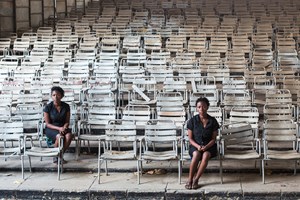
"I believe that the artist can create and talk about art only from his/her subjective position.To have a political responsibility that extends beyond the artistic territory is too much of a burden which could jeopardize the artist's creativity and freedom. In such a case, the art serves a function, becoming a manifesto. Art should not fulfill a function, it should be free. "
Image: Cinema Karl Marx, 2017
Mónica de Miranda is an artist and researcher. Born in Porto (Portugal) she has an Angolan backgound. Her work is based on themes of urban archaeology and personal geographies. Mónica has a visual art degree from Camberwell College of arts (London, 1998); a Master’s degree in art and education at the Institute of Education (London, 2000) and a PhD in visual art from the University of Middlesex (London, 2014). She has received the support from the Foundation for Science and Technology. She is currently developing her research project: Post-archive at CEC (Centre of Comparative Studies, University of Lisbon).
Mónica is one of the founders of the artistic project of residences Triangle Network in Portugal and the founder of the Project Hangar (Center of artistic research in Lisbon, 2014). She exhibits regularly and internationally since 2004 at Museu Berado in Lisbon, 1.54 in New York, Tate Britain in London, Musée des Beaux Arts de Calais in France, Pera Museum in Istanbul, Galerie des Galeries in Paris, Sabrina Amrani Gallery in Madrid, Dakar biennial, Venice Biennial of Architecture etc...
Her work is represented in private and public collections, such as MNAC, AC, AML, CCL.
ArtDependence (AD): Do you have any thoughts on whether artists have a responsibility to reflect on the times we live in, and is this important in a political context?
Monica de Miranda (MM): The question of whether contemporary art has a political and, or civic responsibility is a tricky one. I think that placing a political responsibility on artists is too high of a demand, however, I do believe that art has the power to communicate and inspire an awareness of social and political issues and that it reflects and transforms life.
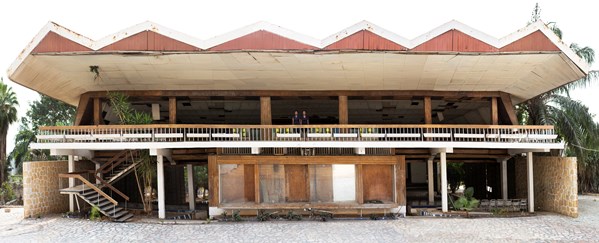
Cinema Karl Marx, 2017
I view the personal as political, therefore, biographical or identity based work can express a political dimension, though it is not responsible to do so. It Is important that artists reflect on their own history in relation to identity politics and attitudes towards issues of belonging and community. In such a process, aspects of people's identities and beliefs function as the common denominators which bring them together. Through personal experiences and creative processes, artists can develop and expand the collective consciousness. The artists then become activators of thought that can truly reflect their zeitgeist and add insight to political critique. Identities are individual and collective narratives that provide answers to the questions:
“ Who am i?”and “Who are we?”?
I believe that the artist can create and talk about art only from his/her subjective position.To have a political responsibility that extends beyond the artistic territory is too much of a burden which could jeopardize the artist's creativity and freedom. In such a case, the art serves a function, becoming a manifesto.
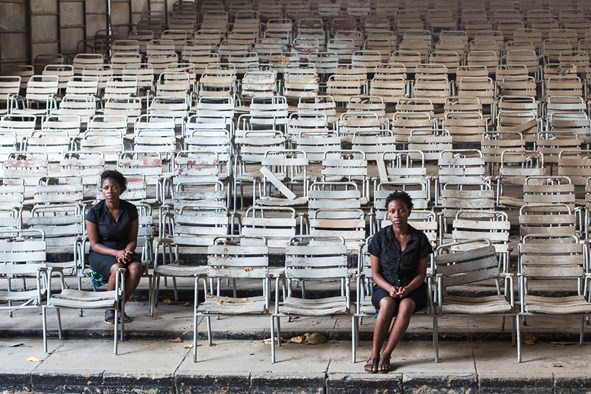
Cinema Karl Marx, 2017
Art should not fulfill a function, it should be free. It should not be an instrument for the expression of intentions other than artistic ones. Nonetheless, making a statement from a private and subjective standpoint, and publicizing it is a political act which activates thinking and action since it draws attention to the connections between personal experiences and larger socio/political structures. The biographical practice exposes and integratesprivate or social matters with political discourse and analysis. It reacts and challenges social constructs by revealing personal stories of power, oppression and exploitation.
AD: What is your main interest as artist? What form of self-consciousness is applicable to the art-making?
MM: For me self-awareness is more applicable to art-making than self consciousness because self-consciousness is a preoccupation with oneself, whereas as self-awareness is a philosophical state, an awareness of the individual's existence in relation to the world at large.
In essence, principles are the only true means for raising consciousness through art. The principles of re-examining original sources, whether it be personal histories or collective histories, transforming theory into practice by focusing on people and experiences are innately radical and political.
I view my “self consciousness” as having a two-fold nature because I tell diasporic stories through the mediums of photography, performance and video which serve as narrators. When we speak from our personal positions, the artistic space is bound to be political. With that in mind, i am interested in creating work that challenges views of history and dominant, paradigmatic notions of place and identity. Coming from an Angolan diaspora means that my place is never fixed. I am born and raised here (Europe), but i am from there (Africa).
I have also been preoccupied with blurring the boundaries of various artistic mediums and disciplines, experimenting with theatre, sound and moving image through a diverse range of collaborative projects. I am interested in examining notions of place, space, time and memory and their connection to issues of identity and belonging through conceptual frameworks such as double consciousness and the third space.
My creative process tends to involve a hybrid approach in terms of concept, style and format. I mix and match fiction with real stories, blending historical accounts and narratives with actual or re-enactments of life situations. The notion of hybridization through blurring and interweaving the real with the virtual is unpacked in the third space, in which I can continuously stretch, obscure and reinvent perceptual boundaries. By applying documentary imaging which alternates between artistic research and camera-based observation practices, I manage to revive the aesthetic aspect of recording the real, whilst providing visual evidence that is critical when assessing and analysing of a broad sense of place and space. The power of mimesis allows me to illuminate, reconstruct, and ultimately reinvent my own world.
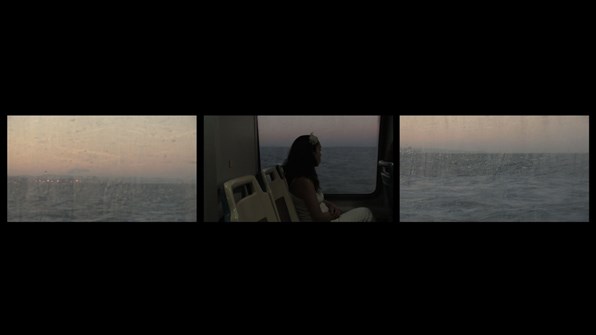
Panorama, 2017
AD: Do you feel that it’s important to convey your own beliefs and opinions within your art? Is there a philosophical element in your work?
MM: Without beliefs or opinions we would be zombie artists that have no substance. Art is similar to philosophy in the sense that it reflects on reality and its relation to the human domain. It may allude to a spiritual world and make propositions about human nature and the ways in which the individual interacts with the world. My work is inseparable from my life, my biography, the geographies of my affections and my interaction with the world. So my philosophy of life is a consistent and intrinsic part of my work. The significance of affections is a district element in my philosophy because emotions are the motivating power behind my ideas. From 2011 to 2016, I have been developing a body of work titled “Geography of Affections”.
The first piece entitled “Home Sweet Sour Home “, was a single drawing that was comprised of multiple drawings of all the houses that I lived in. I created memory maps of the houses in which I have lived. The maps of the houses were representational sketches of dwellings contained within a location or a territory. These maps encompass multiple addresses in a multitude of cities in different locations, regions and countries. There were 25 maps of houses: from squats, to temporary accommodations, to family houses and hostels with addresses in Angola, Brazil, Portugal and the UK. The maps were architectural projections of memories of the houses I passed through from childhood to adulthood. The maps were also representations of houses I have never been to or seen, such as the houses in Angola where my mother and grandparents had lived. These houses signify struggles and conquests, insecurities and securities, absences and presences, oscillating between feelings of belonging and exclusion. I see the ‘house’ as the place where the search forself takes place, a search for identity within the context of diasporic travels/immigration and the territories that are recreated through this experience.
Home is like a return to lost origins, a relic of my own memories. The house is reinvented from a blend of my childhood memories, family stories and my own idiosyncratic myths and fantasies. This work lead to the creation of the video installation “Once upon a time” in which Ivisited and recreated these houses. The research process was a personal quest for self-discovery which spanned across different geographical territories. It was represented through visual renderings of images that captured seas and land across the three different continents in which my family resides. I delineated a personal architecture of my own emotional geographies. I attempted to measure, analyse and represent my cultural references and personal experience of diaspora and migration, whilst striving to represent my desires and ideologies and my own reality as I continuously try to reinvent myself.
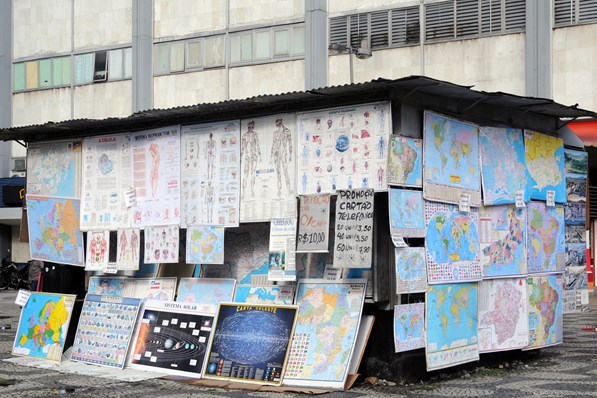
Once upon a time, 2013
AD: What are you currently working on? Is there anything in particular that you’d like to get across through your work?
MM: I am currently working on a film called “Fighting twice”. I am moving into the cinematic medium because of my appreciation for the collaborative aspect of film-making. I want my work to speak to a wider audience after having realized that the work shown in galleries only touches a few. I want to tackle a wider spectrum of human emotions and tell stories. Film offers me new possibilities for explore this. The film that I am developing combines documentary and fiction to depict the struggle of women in Angola, as well as the inner conflicts and dilemmas that are a part and parcel of the diasporic identities. It documents the anti-colonial revolt of the women fighters movement in Angola, and same time, it tells the story of a real character who is a second-generation from the Angolan diaspora living in Portugal. The character's personal story reveals and provides also an insight into the current struggles of single mothers. The plot functions as a link between past and present stories that unravel the complexities of constructed identities in Angola and struggles for liberation. Liberation from colonialism in conjunction with liberation on a personal level. Some of my personal stories are sublimated into fictional elements in the film.
AD: What place does creativity have in education ? Do you view yourself as a creator?
MM: Education without creativity is dead. Education that is devoid of creativity is a lie. My idea of creative education is related to divergent thinking which occurs in a spontaneous, free-flowing, non-linear manner. For far too long, education systems have been promoting linear thinking. Spontaneity was forbidden in their classrooms and the students' freedom of thought was repressed. Lately, creative education has become more integrated into pedagogic curriculums.Creativity enables students to use their imagination and critical thinking abilities to create new and meaningful forms of ideas that gives them the confidence to take risks and become independent and flexible. Instead of being taught to reiterate what was learned, students are encouraged to develop their ability to find a variety of solutions to a problem. They may even come up with surprising out-of-the box solutions.
Artists are good educators because they are perpetually out of the box. When I was living in England in the nineties, I noticed that schools were already aware of the importance of creativity and its ability to save students from dropping out of school.
Artists were considered to be saviours. I have been an educator for 15 years, starting in my early twenties when I worked with underprivileged adolescents in schools and community centres in boroughs of Peckham and Brixton, which were crime-ridden areas in London at the time. Young people were dropping out of school because it did not allow them to be creative and because their cultural views were rejected in the classrooms. The school looked like a battleground as some of the kids were already partaking in criminal behaviour. The teachers had reached a dead end, some were hysterical, others where yelling at the students and many of them where actually scared of what the students may do. As the system was collapsing and failing, they would desperately call the artist to solve the problems.
Consequently, I found myself working with teachers as well as groups that were deemed “Offensive”, to provide artistically creative content for the classrooms and some community centres, in the hope of inspiring motivation in the students. That kind of sharing, transference and exchange of skills has not always been easy but has been really important for my work as a creator. At the time, as an educator, I was able to see the life changing effects of my work on the lives of others far more than I do now.
AD: Do you think that by challenging conventional views, art can truly make a change in the public’s perception?
MM: What we define as 'public' depends on a number of variables, namely the specific cultural contexts and the socio/economic status of the public in question. Socially aware art can change the public perception if it actively expresses an intention to communicate with the public in an engaging way.
Therefore, with regards to affecting public perception, communication plays more of a crucial role than challenging conventions, which may be the underlying intention of the artist, yet to make a change, the public must first be open to it.
AD: How has your work developed since you began, and how do you see it evolving in the future?
MM: My work has changed in parallel to how I changed as a person. It accompanied my personal growth as an individual. When i was in London, i was a migrant , so at that time my work was dealing with these issues. Later after 15 years, when I returned home to Portugal and then to Angola, the work became referential towards my reencounters with the places are close to my family network which I was away from for so many years.
When I returned, I felt like a foreigner in my own culture. Whilst going through the experience of having to readapt, it was as if I was a stranger to my own self. So naturally my work began to deal with these multiple feelings of displacement. The work became more personal, but as it developed it changed into being not so much autobiographical but became more self- referential. I became more and more interested in how places can tell stories that allude to the personal and at the same time, transcend self and locality. This is the case of my work Panorama (2017) and Hotel Globo (2015), in which the workbecame a lens of spatio-temporal and affective references that looked at the multiple geographies and histories of the Luanda city – colonial, post-independence, post-Cold War, post-civil war – in order to think the complexity of its layered present in relation to the past and to imagine the possibility of different futures.
The Panorama (2017) poses larger questions, such as personal and affective, on history, memory, desire and a condition of belonging to manifold spaces and times in an ever-changing processes of personal and collective becoming, particularly those marked by the diasporic experience.
My work in the future will be a continuation of the present and it will evolve as i will evolve. I can say that now I am more interested in telling stories by incorporating and combining a variety elements and mediums other than images and objects.
I am interested in experiences, actions, sounds, words, cinema and research.
I am excited about artistic collaborations and I think that this is where the future of my work is heading. I will continue to engage, initiate and participate as a cultural producer through involvement withartist collectives, organization of workshops, events, exhibitions, residencies and books, as well as activities with other artists, communities and cultural producers. I have been doing this for some years with Hangar,a collective artist space that I founded in Lisbon. Hangarwas launched when Portugal facing a serious socio/economic crisis, so at the time it felt like a utopian community, now is a real experience that offers alternatives to the established art institutions.
AD: Is sophistication, aesthetic and accomplishment in the eye of the beholder?
MM: Aesthetic can be a matter of personal opinion, though I think it is construction that goes beyond opinion. Expression which is dependent upon aesthetic places too much pressure on the art as well as the beholder. I believe art exists beyond the eye of the beholder and that an open relationship between the viewer and the art needs to exist before a true understanding and appreciation can come forward.
AD: What do you think is the social role of art? How would you like to be remembered?
MM: Roles are performed by people in standardized jobs and careers. The artist does something else. He/she obeys a necessity, solves a riddle, tells stories, invents lies, digs a hole, paints with his/her shit, makes a mess, travels, cuts his/her skin to make a sculpture, sets fire to his/her work. No matter what he/she does, and however he/she does it, it is still an act that searches for freedom which cannot be contained in straitjackets such as definitions or roles.
Nonetheless, art functions as an agent of change since the artist is endlessly transforming thought into action.
As an artist, my cultural and social activities extended beyond art-making by creating systems with the capacity to support other artists and communities, to enable them and myself to grow without the pressures of the art world. I want to be remembered for this with respect to the projects I developed. Projects of this nature, namely Hangar, are a part of my art, becausewithout these systems that support others as well as myself, i will be pretending to be an artist. Perhaps it took me longer to get there seeing as such activities take a lot of one's time, yet it kept me alive and my feet in real matters.
Sometimes when i go to the art fairs i see many living artists walking around, but I also see so much dead art on the walls because the artists' focus on sales is killing their art. I believe that when we as artists join in a collective endeavor to create our own artistic systems, we have a better chance of changing for the better. Being an artist who is isolated in his/her studio does not communicate with the real. Art needs to be connected to real human experience. To make art alone is a masturbation. To do it for the system is annihilation.
AD: How does art school form ideas about art? Does it shape people into being certain types of artists?
MM: Art schools are systems, many of which are power structures. The extent of their influence on the students is relative to a particular school and the country in which it is located.
I can talk about my experience as a student in London during the nineties. Personally, I think that the art market does much more of the shaping of artists than the art schools. Art school programs in England place an emphasis on the development of personal student projects, so in a sense, they are utopias that provide a supportive environment which enables experimentation. However, they do not teach you how to be an artist, or in the least, how to build a career and survive as an artist. You graduate and feel that you have been thrown into a void, an unfamiliar territory with a complex set of rules that you whereat exposed to while you where in college. From my class, only two out of thirty students became artists whilst the rest graduated, gave up and went on to do something else.
I recently taught at the Fine Arts Academy of Kinshasa (In the Democratic Republic of Congo) which is dramatically different form the educational model I just described. This conservative fine arts university was built upon many power structures and dogmas which condition the artist and limit his/her freedom. Institutions of this kind are lines-of-production of replicas of artists that copy old masters. They shape the artists into packaged souvenirs. This education can be very damaging.
However, this school is currently undergoing changes that are challenging the old ways and there seems to be a real engagement with these changes. Recent graduates have been actively revolting against their educational conditioning and as a result, we can now see an amazing community of artists in Congo that are creating their own studios and systems which are providing new alternatives to their former education system. I met artists who are teaching other artists within the context of studio collaborations which is proving to be a very effective educational method.
If all schools where to have truly motivated teachers, the quality of education will surely improve.
AD: What do you think about the art world and art market? Do you accept that art is inherently an elitist activity?
MM: Yes the consumption of art is an elitist activity. I believe that when artists create work only to accommodate for the market , they cease to make art and begin to manufacture products.
AD: What’s the last great book you read? Any other thoughts/projects to share?
MM: “The women who run with the wolfs”.
This book explores the ways in which myths and stories provide deep insights into our human nature and self. The author, Clarissa Pinkola Estés analyses myths, fairy tales, folk tales and stories from different cultures to uncover the Wild Woman archetype of the feminine psyche.

ArtDependence Magazine is an international magazine covering all spheres of contemporary art, as well as modern and classical art.
ArtDependence features the latest art news, highlighting interviews with today’s most influential artists, galleries, curators, collectors, fair directors and individuals at the axis of the arts.
The magazine also covers series of articles and reviews on critical art events, new publications and other foremost happenings in the art world.
If you would like to submit events or editorial content to ArtDependence Magazine, please feel free to reach the magazine via the contact page.